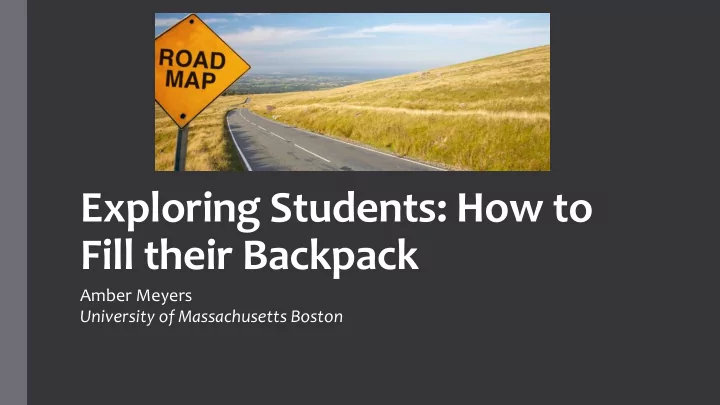

Exploring Students: How to Fill their Backpack Amber Meyers University of Massachusetts Boston
Why this is Important 1. All students are exploring 2. Academic and career advising often overlap 3. Students expect to be prepared for the job search upon graduation 4. Exploration is continual and change is constant
The Student as Explorer Overview of the Different Levels of Student Exploration 1. The Lost Explorer - Totally undecided, exploring all options.
The Student as Explorer 2. The Taste Tester - Numerous talents, strengths, and interests make it difficult to narrow options.
The Student as Explorer 3. The Mostly Decided - Has decided on a major or field of study, now exploring career options and concentrations. OR Counseling Psychologist Human Resources Manager
The Student as Explorer 4. The Re-confirmer - Decided but needs to know how to get there and test out the major or career before committing. May find along the way this path is not truly right for them.
Reflective Exercise 1 Discuss the following question with 1 or 2 partners : What resources and methods do you utilize to help facilitate student major/career exploration?
Facilitating Student Major and Career Exploration Brott’s Storied Approach 1. Constructivist perspective - learning is active, students construct knowledge based on personal experiences, rather than just acquiring it 2. Collaborative process - as students create their personal story in relation to their experiences, advisors actively listen while using facilitating and clarifying questions
How to Start the Conversation Questions to ask 1. What are your strengths and interests? 2. What courses have you enjoyed and/or exceled in? Why? 3. What do you value most? Job security, money, family, or doing work you love? 4. What similarities and differences are there between the majors and career interest areas? Courses required, major requirements and level of challenge? 5. What resources have you accessed so far?
Tools Students can use to Discover Values and Strengths Assessments 1. Forced Choice Values Exercise - sort out values that relate to selecting a career field 2. StrengthsQuest - top five talent themes and action items for development 3. Focus 2 - self-assessment, career and major exploration, decision making and action planning Your campus may have codes or surveys available for students to take a career/major assessment!
Student Activity for Determining and Assessing Values Steps to Value! 1. Read through the entire list of values. 2. Circle 10 life and career values that are most important to you as you explore majors/careers . Ask yourself, “I’m interested in jobs and careers that include …?” 3. How important are these values to you? What are you willing to give up? Now cross out five! 4. Do these TOP 5 Values apply to majors/careers of interest?
Resources Students can use to Explore Majors and Careers 1. What Can I Do with this Major? 2. Occupational Outlook Handbook 3. O*Net 4. Your campus community Students in the major Faculty, staff, advisors Career Center Alumni
Activity Students can do to Explore Majors and Careers The Career Interview: Informational Interviewing 1. Why, how, when, who, and where 2. Guide and questions for the interview 3. Professionalism
Career Interview Questions In your own words, how would you describe your 1. job/position and what you do? What was your major in college (if you attended)? 2. Does your work relate to any experiences or studies you had in college? Describe your career path. 3. Describe a typical work day. 4. If you were hiring a person for your job, what would 5. you look for?
Reflective Exercise 2 How can you encourage student exploration and hold students accountable for actively engaging in the creation of their personal career story?
Thank you! You do great things!
References Brott, P. E. (2001). The Storied Approach: A Postmodern Perspective for Career Counseling. Career Development Quarterly, 49 (4), 304. Retrieved from http://web.b.ebscohost.com/ Brott, P. E. (2004). Constructivist Assessment in Career Counseling. Journal Of Career Development (Springer Science & Business Media B.V.), 30 (3), 189-200. doi:10.1023/B:JOCD.0000015539.21158.53 Images - http://sdtimes.com/wp-content/uploads/2014/10/roadmap.jpg http://i.huffpost.com/gen/303403/images/s-LOST-large.jpg http://careertoran.com/wp-content/uploads/2015/07/Extracurricular-activities-Engineering-student.jpg http://m.c.lnkd.licdn.com/mpr/mpr/p/7/005/088/029/03ab3f0.jpg http://images.businessweek.com/ss/08/06/0613_best_cities_job/image/hr_manager.jpg http://www.bostonpic.org/sites/default/files/u2/job_shadow_lab.jpg http://www.mikekrass.com/wp-content/uploads/2014/08/values.jpg http://www.gannett-cdn.com/-mm-/9d4dd4e8dfdcf61c019ff1954915d8cb47d935d7/c=49-0-789-556&r=x404&c=534x401/local/- /media/2015/04/15/WTSP/WTSP/635646827757204520-635646503201134370-HT-sam-griner-then-02-jef-150413-16x9-992.jpg http://www.advfund.com/img/user_images/19503.jpg
Recommend
More recommend